HUL’s Dual Strategy: Volume Growth vs Premiumisation
Under new CEO Priya Nair, Hindustan Unilever is focusing on fewer, bigger bets in high-growth niches while pushing for volume growth amid softening commodity prices and GST cuts affecting 40% of its portfolio.
Key Challenges
Analysts suggest HUL faces a critical choice: pursue mass-market volume growth or premiumise for better margins. The company faces increasing competition from regional, local, and direct-to-consumer (D2C) brands in a low-inflation environment.
“Though enabling factors such as income tax cuts and GST rate reductions have put more money in the hands of consumers, people are prioritising paying off debt, savings and making purchases of durable items. The basket for FMCG expenditure is actually limited. And there are local and D2C brands competing for attention,” G Chokkalingam, founder of Mumbai-based Equinomics Research, said.
Consumer Spending Shifts
The Kharcha 3.0 study reveals household budgets are increasingly allocated to education and debt repayment. While consumers prioritize essentials and some impulse buys, many are switching to cheaper alternatives.
HUL’s Response
HUL plans to reinvest gross margin savings to combat competition. The company is increasing advertising spend and introducing access packs for premium brands to improve penetration.
“We are clear that we will invest in different lines of the P&L to ensure that we achieve competitive volume growth,” CFO Ritesh Tiwari said.
Market Segmentation Strategy
Nair aims to segment consumers into three categories: premiumisers, power spenders, and democratisers. The strategy includes focusing on low-penetration categories like body wash (2% penetration) and expanding established brands like Vaseline into new segments.
“We will continuously and radically segment consumers,” Nair stated.
Unilever’s Support
Unilever CEO Fernando Fernandez endorsed the India strategy, noting GST reforms will boost medium-term demand despite short-term impacts. He emphasized India’s strong positioning in Unilever’s emerging markets portfolio.




